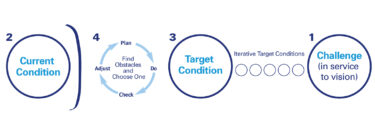Repetitive tasks can create a drag on workers’ morale and motivation as boredom sets in, and a disillusioned workforce will seriously hamper your lean efforts. So how do you keep repetitive tasks from becoming a source of discontent for your people? Is it a matter of changing the work? Is it about changing the mindset of your people and not even touching the work? Three experienced lean practitioners weigh in:
Dan Papsidero (Site Lean Manager, Moog Aircraft Group)
 Based on my experience, implementing certain lean tools can help! Two of them are outlined below:
Based on my experience, implementing certain lean tools can help! Two of them are outlined below:
Single-piece-flow – When you begin using standard work you are going to be designing and documenting the work so it is performed in the best way the organization knows at that point in time. It is likely that the work will now be done in a single-piece-flow work cell that is set up such that one operator could perform all the tasks. This inherently begins to solve the problem because you are moving from small repetitive tasks designed for batch and queue, to a flowing manufacturing line on which workers do multiple steps. In many cases, this gets workers out of the chair (read: boring!) and they begin to move within the cell. This increases the energy of the employees while diversifying the work they perform. When walking through either type of facility, those with sitting batch processes or those with single-piece-flow cells with standard work, it is evident which is full of energy and which is not.
Multi-disciplinary cross-training – As single-piece-flow and other aspects of lean are implemented, the need to have a flexible workforce will quickly surface. Hence, cross-training will be needed for the organization to be successful – and this will also help solve the problems associated with workers getting bored and losing motivation. Use organizational needs and the desires of the employees to set detailed training plans that might include promotional opportunities. New work prevents boredom and promotional opportunities motivate workers.
As an example, I had an employee who had been doing the same job in our Aftermarket Repairs department for about five years and was exhibiting signs of boredom. I engaged the employee and confirmed he was bored, but also interested in gaining new skills he could use in the future. At the same time, our Aerospace value stream needed support for a program that was ramping up in the very near future.
I worked with the supervisor of the area to get this employee working there part time. Then I made a deal with the employee. There were 15 skills on the matrix for that work cell. Once he was proficient at five of them he would be given a full time position. Once he became proficient in 10 skills, he would move up a level. And when he’d learned all 15 skills, up another level he went. The supervisor was fully on board because hiring was always a problem due to skillset mismatches and this employee already knew a lot about the parts they were manufacturing. We also knew that the process to move up to a level III would take two years, which provided a long-term path forward. At the end of the day the employee was happy and motivated, the supervisor was satisfied, and we were able to kill two birds with one stone.
Tim Kane (Continuous Improvement Director, Vermont Energy Investment Corporation)
 Maximizing motivation, productivity and morale (MPM) in a repetitive task environment can be a challenge not only on the shop floor, but also on the administrative side. While it might be tempting to focus on changing workers’ perspectives without even touching the work, presumably because that might seem to be the “least disruptive” approach, I’ve observed that approach to be quite counterproductive. MPM problems are seldom caused by repetitive tasks in a process, but rather a failure to educate and empower process workers to periodically and meaningfully engage in value stream analysis and kaizen improvement efforts. In a lean office environment, workers have real input into (and effective ownership of) process improvements. Perceptions change from “doing assigned tasks” to executing a process they have co-designed with their co-workers. KPI metrics, when they are collectively understood and co-owned, are no longer perceived as management’s monitoring mechanism, but rather a communal dashboard, having far greater positive impact on MPM than the most skilled manager could possibly achieve.
Maximizing motivation, productivity and morale (MPM) in a repetitive task environment can be a challenge not only on the shop floor, but also on the administrative side. While it might be tempting to focus on changing workers’ perspectives without even touching the work, presumably because that might seem to be the “least disruptive” approach, I’ve observed that approach to be quite counterproductive. MPM problems are seldom caused by repetitive tasks in a process, but rather a failure to educate and empower process workers to periodically and meaningfully engage in value stream analysis and kaizen improvement efforts. In a lean office environment, workers have real input into (and effective ownership of) process improvements. Perceptions change from “doing assigned tasks” to executing a process they have co-designed with their co-workers. KPI metrics, when they are collectively understood and co-owned, are no longer perceived as management’s monitoring mechanism, but rather a communal dashboard, having far greater positive impact on MPM than the most skilled manager could possibly achieve.
If for some reason I thought I could address an MPM problem without touching the work (we all go through our delusional phases), cross-training might be a good place to start. I once worked extensively with an administrative support function responsible for enrolling subscribers. Their process was a series of tedious, repetitive tasks involving credit checks, enrollment form processing, data entry, billing setup and fulfillment materials processing. The tasks were completed by respective specialists and suffice it to say, their MPM was the pits. Yes, we definitely “touched the work” in our improvement efforts, but I’m convinced that our most impactful kaizen was to implement a cross training discipline. Eventually, all team members developed the skills to execute any of the tasks in the process and would regularly “mix it up” on assigned duties. This kept the work fresh and interesting, minimized the impact of absences and profoundly improved their collective understanding of the process, soup to nuts.
Aaron Hunt (Director of Performance Improvement, Washington Health System)
 What I hear in this question is “How do we avoid workers becoming disengaged?” I started my career on an assembly line; every 43 seconds I would install the same 12 screws, so I have felt the threat of disengagement first hand in this scenario. I believe there are a few facets to any potential solution regarding repetitive work. The very first thing that comes to mind is respect for the worker by mitigating repetitive stress injury. Typically, my teams have been cross-trained in multiple jobs, ideally at least four different tasks that require different motions. This helps reduce the risk of injury, but it simultaneously addresses your concern of boredom, and the resultant impact on productivity and morale. This concept also applies to knowledge workers as well.
What I hear in this question is “How do we avoid workers becoming disengaged?” I started my career on an assembly line; every 43 seconds I would install the same 12 screws, so I have felt the threat of disengagement first hand in this scenario. I believe there are a few facets to any potential solution regarding repetitive work. The very first thing that comes to mind is respect for the worker by mitigating repetitive stress injury. Typically, my teams have been cross-trained in multiple jobs, ideally at least four different tasks that require different motions. This helps reduce the risk of injury, but it simultaneously addresses your concern of boredom, and the resultant impact on productivity and morale. This concept also applies to knowledge workers as well.
The second is connection with purpose. The job may be repetitive, but do the workers understand why it’s important? What impact on Quality, Safety, or Customer Satisfaction does their job entail? For example, in my current role, our housekeeping team cleans about 75 hospital rooms per day. When they thought of it as simply cleaning rooms, our staff turnover was higher, call offs were much higher, and cleaning effectiveness was poor. However, as the team began to understand that their job helped prevent infections, allowed patients to get admitted faster, and added to the overall positive experience of patients and families in the organization, all of those performance indicators improved. If you can’t connect what the worker is doing to a purpose, perhaps in this case the work should be changed or eliminated.
The third facet I’ve experienced is connection with the organization. I believe this connection needs to be created through communication on two levels: genuine interest in the worker as a person, and regarding their performance. The performance part is probably the easiest: do the workers have a way to know if they hit their targets at the end of every day? Almost every person I’ve worked with – whether in manufacturing, engineering and product development, retail sales, or healthcare – responds positively and is energized by measuring the right things that they can control and care about. The other comes down to effective leadership. Does the leader know his or her team, respect their ideas, communicate goals and expectations, provide feedback, and show appreciation? Many leaders consider these “soft skills” as less important, but they’re an effective way to prevent disengagement. Lean really is about people. By starting with this last suggestion, it often makes the others easier to implement effectively.





